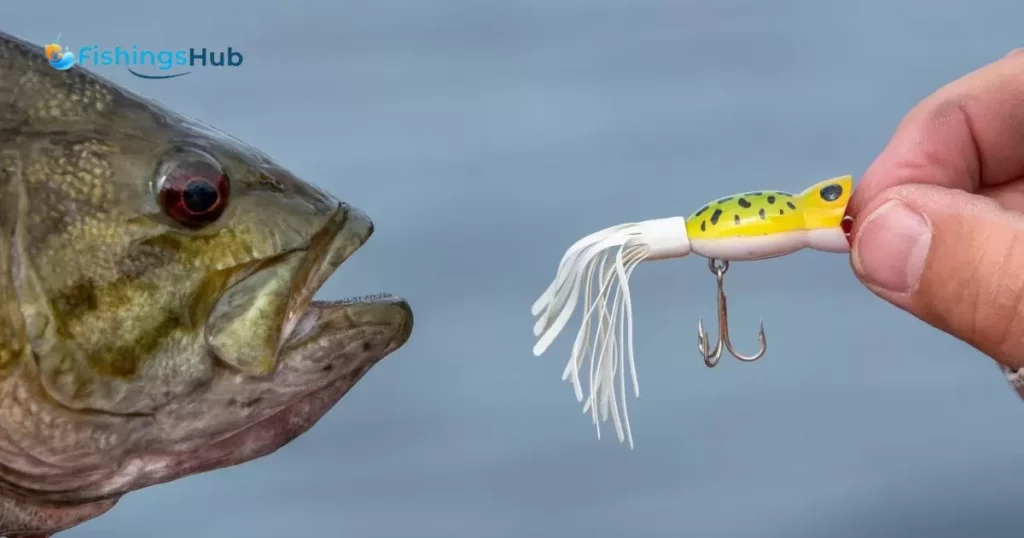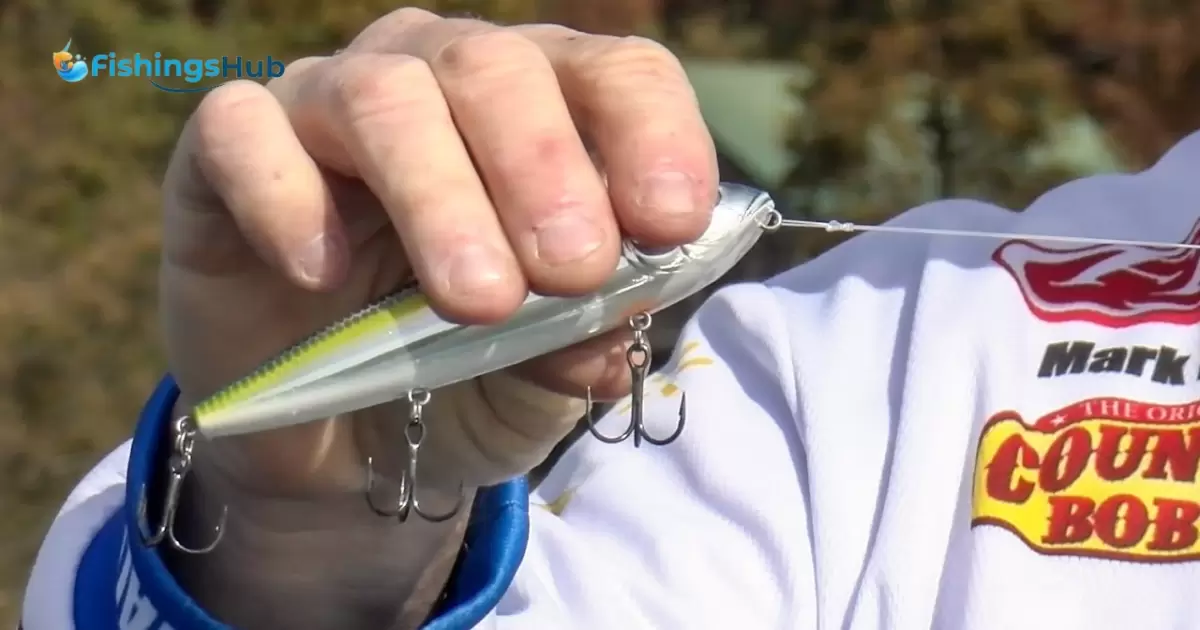A popper for bass fish refers to a type of topwater lure designed to mimic distressed baitfish. It’s characterized by a concave or cupped face that, when jerked, creates a splashing or popping sound on the water’s surface. This noise and motion imitate a struggling prey, attracting bass to strike.
How do I fish a popper for bass? Imagine the thrill of luring bass to the surface with a perfectly executed popper action. Learning the art of manipulating this lure can entice even the most cautious bass to strike. It’s a skill that combines finesse and strategy to make that pop and wiggle irresistible to the bass.
Cast near cover or structures where bass might lurk, then let the popper settle. Utilize gentle jerks on the line to create the popping action. The key is to vary the rhythm and pauses, mimicking the irregular movements of wounded prey. Selecting the appropriate length rod for bass fishing is crucial for achieving optimal casting distance and control.
Bass Behavior and Popper Lures
Understanding bass behavior is key in successful popper fishing. Bass are opportunistic predators that often respond to surface disturbance, making poppers an enticing choice. These lures mimic distressed baitfish, drawing bass to the surface.
Knowing the feeding patterns and preferences of bass, such as their tendency to strike at dawn or dusk, aids in choosing the right time to use poppers. Recognizing that bass often lurk near structures or in shallower waters during specific seasons can guide your popper fishing strategy.
Right Popper for Bass Fishing
The right popper can make all the difference. Consider the size and color of the popper, aiming for those that closely resemble the local forage. Matching the hatch increases the likelihood of enticing strikes. Factors in the water conditions, such as clarity and the presence of cover, when selecting a popper.
Opt for a size and shape that suits the prevailing conditions for better visibility and disturbance on the water’s surface, ultimately attracting bass. Experimenting with various popper styles allows for understanding which ones yield the best results in different environments.
Selecting the Right Popper for Bass Fishing and then follow it with a brief paragraph to complement the table.
| Popper Type | Size | Color | Water Conditions | Best Use |
| Pencil Popper | 4-6 inches | Natural shades | Clear to slightly | Mimics wounded baitfish, ideal for open |
Essential Gear for Bass Fishing with Poppers
Proper gear is essential for effective popper fishing. A sturdy, medium to medium-heavy action rod of around 6 to 7 feet, paired with a quality reel spooled with the appropriate line, ensures control and accurate casting.
Using polarized sunglasses aids in spotting bass movement and strikes. Having a selection of poppers in various sizes, colors, and shapes diversifies your approach, while a hat and sunscreen contribute to a comfortable and safe fishing experience.
Techniques for Casting Poppers in Bass Fishing

Mastering the art of casting poppers is crucial. Start by assessing the water and locating potential bass hiding spots, then cast the popper beyond the targeted area. Using a gentle and controlled retrieve, create a rhythmic pop by twitching the rod tip, imitating the sound of distressed prey.
Vary the speed and duration of your retrieval to entice different bass behaviors. Pay attention to the line for any sudden movement, as strikes can often be subtle. Mastering the cadence of pops and pauses in the retrieve significantly increases the chance of luring bass to strike.
Topwater Tactics for Bass Fishing with Poppers
When employing topwater tactics with poppers for bass fishing, the key is to create enticing movements on the water’s surface. Use a jerking motion to simulate a wounded or struggling prey. Poppers are designed to create a distinct ‘popping’ sound, so employ varied retrieval speeds to elicit strikes. Patience is crucial; allow the ripples to settle before your next pop to attract curious bass. Experiment with different retrieval styles to determine what triggers the most action from the bass.
Bass Strikes and Hooking Techniques with Poppers
Bass often strike poppers aggressively. When you witness a bass strike, resist the urge to set the hook immediately. Wait a split second to ensure the bass has the lure in its mouth before setting the hook with a swift, controlled motion.
For better hooking, use a slightly longer pause before setting the hook to allow the bass to engulf the popper completely. This technique significantly reduces the number of missed hooksets. Ensure your gear is appropriate for a solid hookset without overpowering the bass.
Adapting to Various Conditions in Bass Fishing with Poppers
Different conditions require varying approaches. In calm waters, gentle pops with longer pauses often attract bass. In windy conditions, adjust your casting angle and strength to ensure the proper popping action. Experiment with different popper styles and sizes to match the prevalent conditions and the bass’s preferences.
Tips for Mastering Popper Bass Fishing
Consistency is key when mastering popper bass fishing. Practice your casting accuracy and retrieval techniques regularly. Experiment with different popper designs and sizes to determine what works best in different conditions. Observing and learning from the behavior of bass when using poppers will refine your skills over time. Remember, patience and adaptation are crucial for successful bass fishing with poppers.
FAQs
What makes poppers effective for bass fishing?
Poppers imitate distressed or injured prey with their unique ‘popping’ sound, attracting bass by stimulating their predatory instincts.
How do I choose the right popper for bass fishing?
Consider the size and color of the popper, matching it to the prevalent conditions and the bass’s feeding habits for optimal results.
Can I fish poppers in various weather conditions?
Yes, adapting your technique to different weather conditions is key—adjust casting and retrieval styles to suit windy or calm waters.
What’s the best way to hook a bass when using poppers?
Allow a brief pause after a strike before setting the hook, ensuring the bass has fully taken the popper before setting the hook.
Any tips for beginners to improve popper bass fishing?
Practice regularly, experiment with different techniques, and observe bass behavior to refine your skills over time.
Conclusion
Mastering bass fishing with poppers requires patience and dedication. By understanding the behaviors of both bass and the techniques to manipulate poppers, anglers can enhance their success. Practice makes perfect regularly honing your skills, adapting to various conditions, and experimenting with different popper styles will ultimately lead to a more fruitful and enjoyable bass fishing experience. With time and experience, the thrill of coaxing bass to strike your popper will become a rewarding and fulfilling aspect of your fishing endeavors.
It’s not just about the catch; it’s about the process, the finesse in manipulating the lure, and the anticipation before each strike. If you want to enhance your bass fishing experience, consider adding a new dimension to your approach. Fish a popper for bass and discover the thrill of enticing strikes with surface action.

